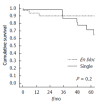Single vs dual (en bloc) kidney transplants from donors ≤ 5 years of age: A single center experience
- PMID: 27011923
- PMCID: PMC4801801
- DOI: 10.5500/wjt.v6.i1.239
Single vs dual (en bloc) kidney transplants from donors ≤ 5 years of age: A single center experience
Abstract
Aim: To compare outcomes between single and dual en bloc (EB) kidney transplants (KT) from small pediatric donors.
Methods: Monocentric nonprospective review of KTs from pediatric donors ≤ 5 years of age. Dual EB KT was defined as keeping both donor kidneys attached to the inferior vena cava and aorta, which were then used as venous and arterial conduits for the subsequent transplant into a single recipient. Donor age was less useful than either donor weight or kidney size in decision-making for kidney utilization as kidneys from donors < 8 kg or kidneys < 6 cm in length were not transplanted. Post-transplant management strategies were standardized in all patients.
Results: From 2002-2015, 59 KTs were performed including 34 dual EB and 25 single KTs. Mean age of donors (17 mo vs 38 mo, P < 0.001), mean weight (11.0 kg vs 17.4 kg, P = 0.046) and male donors (50% vs 84%, P = 0.01) were lower in the dual EB compared to the single KT group, respectively. Mean cold ischemia time (21 h), kidney donor profile index (KDPI; 73% vs 62%) and levels of serum creatinine (SCr, 0.37 mg/dL vs 0.49 mg/dL, all P = NS) were comparable in the dual EB and single KT groups, respectively. Actuarial graft and patient survival rates at 5-years follow-up were comparable. There was one case of thrombosis resulting in graft loss in each group. Delayed graft function incidence (12% dual EB vs 20% single KT, P = NS) was slightly lower in dual EB KT recipients. Initial duration of hospital stay (mean 5.4 d vs 5.6 d) and the one-year incidences of acute rejection (6% vs 16%), operative complications (3% vs 4%), and major infection were comparable in the dual EB and single KT groups, respectively (all P = NS). Mean 12 mo SCr and abbreviated MDRD levels were 1.17 mg/dL vs 1.35 mg/dL and 72.5 mL/min per 1.73 m(2) vs 60.5 mL/min per 1.73 m(2) (both P = NS) in the dual EB and single KT groups, respectively.
Conclusion: By transplanting kidneys from young pediatric donors into adult recipients, one can effectively expand the limited donor pool and achieve excellent medium-term outcomes.
Keywords: Donor age; Donor weight; En bloc kidney transplant; Kidney donor profile index; Single kidney transplant; Small pediatric donor.
Figures
References
-
- Matas AJ, Smith JM, Skeans MA, Thompson B, Gustafson SK, Stewart DE, Cherikh WS, Wainright JL, Boyle G, Snyder JJ, et al. OPTN/SRTR 2013 Annual Data Report: kidney. Am J Transplant. 2015;15 Suppl 2:1–34. - PubMed
-
- Rana A, Gruessner A, Agopian VG, Khalpey Z, Riaz IB, Kaplan B, Halazun KJ, Busuttil RW, Gruessner RW. Survival benefit of solid-organ transplant in the United States. JAMA Surg. 2015;150:252–259. - PubMed
-
- Available from: http://www.unos.org/donation.
-
- Wolfe RA, Ashby VB, Milford EL, Ojo AO, Ettenger RE, Agodoa LY, Held PJ, Port FK. Comparison of mortality in all patients on dialysis, patients on dialysis awaiting transplantation, and recipients of a first cadaveric transplant. N Engl J Med. 1999;341:1725–1730. - PubMed
LinkOut - more resources
Full Text Sources
Other Literature Sources
Research Materials
Miscellaneous



